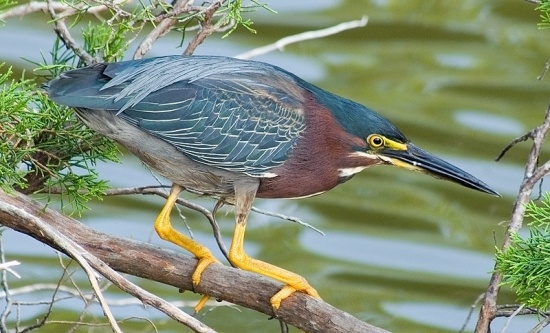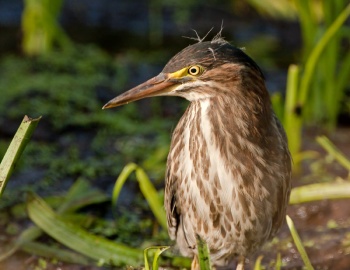- Butorides virescens
Identification
A very small heron: L. ca. 16½ in (42 cm)
Adult
Adults generally distinctive, but see the Striated Heron
- Grayish-green back
- Whitish or buff edging to wing-coverts
- Dark greenish cap - this will occasionally be raised as a bushy crest
- White stripe runs from the chin to the central chest
- Auriculars, neck and flanks are chestnut-brown
- Belly is paler and greyer
- Yellowish legs (brighter when breeding)
Juveniles
- Brown
- Whitish-buff streaking on underparts, neck and head
- Spotting on wings
Similar Species
Juveniles are virtually inseparable from Striated Heron while most adults can be identified with care (see identification essay linked to under External links). Overlap of the two species limited to eastern Panama, Trinidad and Tobago and coastal northern Colombia and Venezuela.
Distribution
North America
Breeds over much of the eastern half of the continent from extreme south-eastern Canada south to the Gulf Coast and also on the Californian coast. Occurs throughout Mexico, Central America and the West Indies and Aruba, Bonaire, and Curaçao and Tobago (most birds in Trinidad are Striated Heron).
Birds from the northernmost part of its range are migratory and winter from California, the Gulf Coast and Florida southwards. Main passage periods March-April and September-October.
South America
Restricted to coastal N. Colombia and Venezuela. Also a few records from Ecuador, C. Colombia, and Suriname.
Vagrancy
Vagrants from North America have been recorded in the Western Palearctic: at least six times in the Azores and four in Britain; Cornwall in October 1889, East Yorkshire in November-December 1982, East Lothian in October 1987 and Lincolnshire in September 2001. In addition there was one present on Jersey and Guernsey in the Channel Islands in August-September 1992.
The first Icelandic record was of one shot in October 2001 and the first for France was in Morbihan in April 1994.
Taxonomy
It has commonly been considered a subspecies of the Striated Heron.
Subspecies
There are 4 subspecies[1]:
- B. v. virescens:
- B. v. bahamensis:
- B. v. anthonyi:
- Western US and northern Baja California
- B. v. frazari:
- Southern Baja California
Habitat
Occurs in a wide variety of habitats near water, incl. swamps, wet woodlands, marshes, coastal lagoons and mangrove. Generally common, but difficult to observe.
Behavior
Diet
Feeds on fishes, crustaceans, insects and other small animals.
Breeding
Breeds alone or in small groups. Breeding-season varies. The typically 2-5 eggs are laid in a well-hidden nest placed low in trees, bushes or mangrove.
References
- Clements, J. F., T. S. Schulenberg, M. J. Iliff, D. Roberson, T. A. Fredericks, B. L. Sullivan, and C. L. Wood. 2017. The eBird/Clements checklist of birds of the world: v2017, with updates to August 2017. Downloaded from http://www.birds.cornell.edu/clementschecklist/download/
- Disucssion on racial identification
- An identification essay comparing Green and Striated Herons
Recommended Citation
- BirdForum Opus contributors. (2025) Green Heron. In: BirdForum, the forum for wild birds and birding. Retrieved 1 May 2025 from https://www.birdforum.net/opus/Green_Heron
External Links
GSearch checked for 2020 platform.1







